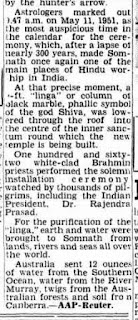It wasn’t about curbing gunrunning, or bootlegging, or prostitution. The ‘UP Milk and Milk Products Control Order’ was all about preventing the diversion of milk to other states, and for other uses, such as the production of paneer and mithai in the summer months.
Nor was UP alone in this. In August 1965, West Bengal had banned the manufacture of dairy sweets in Kolkata through the West Bengal Channa Sweets Control Order. Punjab’s milk products control order had come into force in June 1966. The Centre had issued ‘Delhi, Meerut and Bulandshahr Milk and Milk Products Control Order’ in 1969. And in Delhi, wedding hosts weren’t allowed to serve sweets made of “khoya, chhana, rabri and khurchan to more than 25 persons at a time at social functions,” following an order passed in 1965.
All of these orders were meant to fight the severe shortage of milk in the summer months when fodder and water for milch animals were scarce. Even otherwise, India was a milk-starved country in the first few decades after Independence. During 1952-55, hardly half a cup of milk (126g) was available per person, per day. In some states, the average daily availability was just 30-50 grams per person.
A large part of the country’s milk requirement was fulfilled with imported – often donated – milk powder. On March 29, 1967, this discussion occurred in the Rajya Sabha:
Niren Ghosh, MP from West Bengal: “There is dearth of milk powder supply in West Bengal. As a result, the entire milk supply scheme is going to collapse next month, and the children and the mothers are not going to get milk.”
S Chandrasekhar, minister of health and family planning: “I know, sir…all the available supplies are being directed to Bihar because of the drought situation…even in Bihar, since the supplies are limited, they are being directed for the use of vulnerable groups of population like nursing mothers and infants and young children.”
So, the policymakers of that era had a reason to ban the diversion of milk for all “non-essential” uses, including mithai. “Government are aware that manufacturers of milk sweets will be adversely affected. But milk sweets are a luxury product…” minister of state for agriculture Annasaheb Shinde said in May 1969.
Happily, Operation Flood was successful, and at the start of the 1990s you find minister of state for agriculture K C Lenka telling Lok Sabha: “now the ban is on conversion of milk into milk powder and condensed milk only.”
Three more decades have passed, and few remember those summers of milk shortage. Now, if a cop knocks at your door, you know he won’t say, “Got milk?”.
*
Nor was UP alone in this. In August 1965, West Bengal had banned the manufacture of dairy sweets in Kolkata through the West Bengal Channa Sweets Control Order. Punjab’s milk products control order had come into force in June 1966. The Centre had issued ‘Delhi, Meerut and Bulandshahr Milk and Milk Products Control Order’ in 1969. And in Delhi, wedding hosts weren’t allowed to serve sweets made of “khoya, chhana, rabri and khurchan to more than 25 persons at a time at social functions,” following an order passed in 1965.
All of these orders were meant to fight the severe shortage of milk in the summer months when fodder and water for milch animals were scarce. Even otherwise, India was a milk-starved country in the first few decades after Independence. During 1952-55, hardly half a cup of milk (126g) was available per person, per day. In some states, the average daily availability was just 30-50 grams per person.
A large part of the country’s milk requirement was fulfilled with imported – often donated – milk powder. On March 29, 1967, this discussion occurred in the Rajya Sabha:
Niren Ghosh, MP from West Bengal: “There is dearth of milk powder supply in West Bengal. As a result, the entire milk supply scheme is going to collapse next month, and the children and the mothers are not going to get milk.”
S Chandrasekhar, minister of health and family planning: “I know, sir…all the available supplies are being directed to Bihar because of the drought situation…even in Bihar, since the supplies are limited, they are being directed for the use of vulnerable groups of population like nursing mothers and infants and young children.”
So, the policymakers of that era had a reason to ban the diversion of milk for all “non-essential” uses, including mithai. “Government are aware that manufacturers of milk sweets will be adversely affected. But milk sweets are a luxury product…” minister of state for agriculture Annasaheb Shinde said in May 1969.
Happily, Operation Flood was successful, and at the start of the 1990s you find minister of state for agriculture K C Lenka telling Lok Sabha: “now the ban is on conversion of milk into milk powder and condensed milk only.”
Three more decades have passed, and few remember those summers of milk shortage. Now, if a cop knocks at your door, you know he won’t say, “Got milk?”.
*












